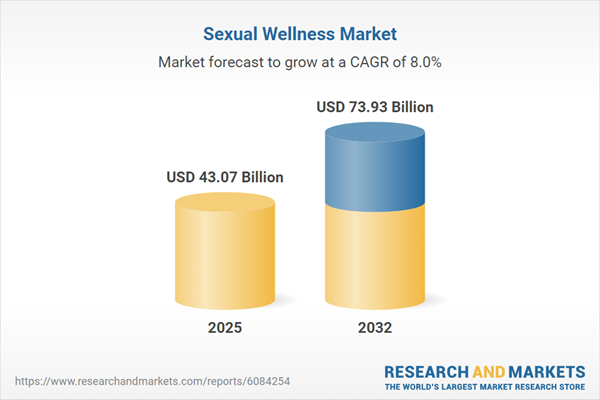Speak directly to the analyst to clarify any post sales queries you may have.
The sexual wellness market is evolving rapidly, shaped by shifting consumer expectations, technological innovation, and expanding product portfolios. Senior decision-makers can leverage these market changes to identify new opportunities for growth, adapt to regulatory landscapes, and make informed strategic investments.
Market Snapshot: Sexual Wellness Market Size and Growth
The Sexual Wellness Market expanded from USD 40.07 billion in 2024 to USD 43.07 billion in 2025, with ongoing momentum expected at a CAGR of 7.95%, positioning the sector to reach USD 73.93 billion by 2032. This consistent growth reflects heightened demand for products and services, as well as increased mainstream acceptance of sexual wellness solutions among a broadening consumer base.
Scope & Segmentation
This comprehensive research report on the sexual wellness market covers in-depth segments and analyzes emerging trends across diverse geographies and product categories:
- Product Types: Condoms, Fertility & Pregnancy Rapid Test Kits, Intimate Care, Personal Lubricants (oil-based, silicone-based, water-based), Sexual Enhancement Supplements (herbal supplements, hormonal boosters, vitamins & minerals), Sexual Wellness Devices & Toys.
- Distribution Channels: Online Retailers, Pharmacies & Drug Stores, Specialty Stores, Supermarkets & Hypermarkets.
- Age Groups: 18-24 Years, 25-34 Years, 35-44 Years, 45 & Above.
- End-user Demographics: Female, Male.
- Regional Coverage: Americas (North America: United States, Canada, Mexico; Latin America: Brazil, Argentina, Chile, Colombia, Peru), Europe, Middle East & Africa (Europe: United Kingdom, Germany, France, Russia, Italy, Spain, Netherlands, Sweden, Poland, Switzerland; Middle East: United Arab Emirates, Saudi Arabia, Qatar, Turkey, Israel; Africa: South Africa, Nigeria, Egypt, Kenya), Asia-Pacific (China, India, Japan, Australia, South Korea, Indonesia, Thailand, Malaysia, Singapore, Taiwan).
- Technologies: Connected devices, app-enabled solutions, AI-driven recommendations, sustainable packaging, advanced manufacturing, biotechnology integrations.
Key Takeaways for Sexual Wellness Market Stakeholders
- Technological convergence is bridging healthcare and consumer products, enabling personalized experiences and driving digital engagement within the sexual wellness market.
- Cultural openness and sustained educational initiatives are fueling acceptance of a wider array of sexual wellness products, improving reach across age and gender segments.
- Channel strategy is critical as online retail becomes the preferred choice for younger consumers, while traditional outlets continue to attract those seeking assurance and immediate access.
- Emerging regulatory changes are prompting manufacturers to elevate safety, ingredient transparency, and cybersecurity, supporting consumer confidence.
- Competitive differentiation is shifting toward sustainable packaging, personalized formulas, and digital health integration, compelling established brands and new entrants to focus on innovation.
- Regional heterogeneity requires tailored approaches, as adoption rates, consumer priorities, and regulatory environments differ widely across North America, Europe, Middle East, Africa, and Asia-Pacific.
Tariff Impact: U.S. 2025 Adjustments
Revised U.S. tariff structures in early 2025 have introduced procurement and cost challenges for manufacturers, particularly those dependent on imported raw materials or finished goods. Market participants are responding with regional supply optimization, alternative sourcing strategies, and product portfolio recalibrations to maintain competitive pricing and operational resilience. These tariff dynamics are also catalyzing innovation in manufacturing localization, with local partnerships and advanced technology investments taking precedence.
Methodology & Data Sources
The research utilizes a robust methodology, integrating primary engagements—such as qualitative interviews with executives, clinicians, and focus groups—with comprehensive secondary analysis of financial filings, regulatory databases, patents, and real-time digital sentiment. Triangulation and iterative peer review safeguard accuracy and actionable insight for decision-making.
Why This Report Matters for Senior Decision-Makers
- Enables proactive strategic direction through detailed segmentation, trend analysis, and regulatory intelligence across the entire sexual wellness market value chain.
- Equips leadership with real-world best practices and actionable initiatives for supply chain optimization, omnichannel expansion, and product innovation.
- Supports risk management and compliance through transparent evaluation of tariff and regulatory environments, helping organizations maintain stakeholder confidence and brand integrity.
Conclusion
The sexual wellness market is characterized by dynamic innovation, evolving consumer needs, and complex regulatory landscapes. Senior leaders who act decisively on these insights will strengthen market positioning and future-proof their strategic investments.
Table of Contents
3. Executive Summary
4. Market Overview
7. Cumulative Impact of Artificial Intelligence 2025
Companies Mentioned
The companies profiled in this Sexual Wellness market report include:- Aneros
- Bijoux Indiscrets SL
- BioFilm, Inc. by Combe Incorporated
- BMS Factory
- California Exotic Novelties, LLC
- Church & Dwight Co.,Inc.
- Convex Latex Pvt. Ltd.
- Dabur Ltd.
- Diamond Products
- Doc Johnson Enterprises
- HANX
- HLL Lifecare Ltd.
- Hot Octopuss Ltd.
- Karex Berhad
- Kessel Medintim GmbH
- Kindly Health
- LELOi AB
- LifeStyles Healthcare Pte. Ltd.
- Lovehoney Group
- Lovelife by OhMiBod
- Mankind Pharma Ltd.
- Okamoto Industries,Inc.
- Reckitt Benckiser Group PLC
- Sagami Rubber Industries Co., Ltd.
- Satisfyer
- Tantus, Inc
- TENGA Co., Ltd.
- Topco Sales
- Vella Bioscience, Inc.
- Veru Inc.
- WOW Tech Group
Table Information
| Report Attribute | Details |
|---|---|
| No. of Pages | 183 |
| Published | November 2025 |
| Forecast Period | 2025 - 2032 |
| Estimated Market Value ( USD | $ 43.07 Billion |
| Forecasted Market Value ( USD | $ 73.93 Billion |
| Compound Annual Growth Rate | 7.9% |
| Regions Covered | Global |
| No. of Companies Mentioned | 32 |









